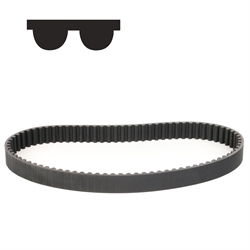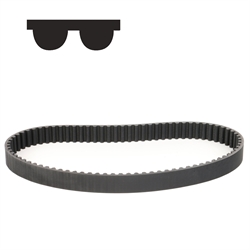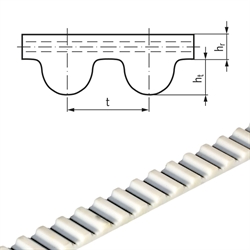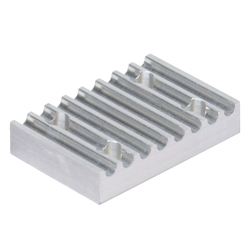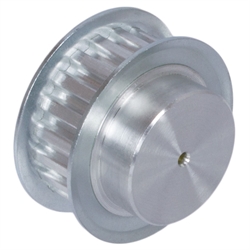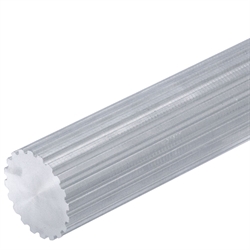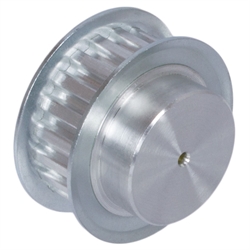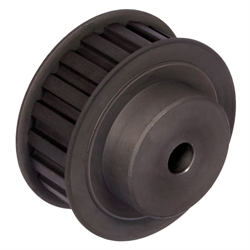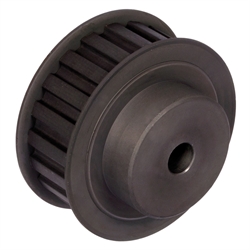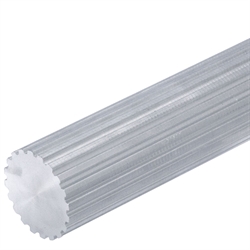Timing belt and pulley
Description
Timing belt drives ensure quiet operation and synchronous power transmission. Because they are maintenance-free, these drives are highly cost-effective. Due to changing requirements and considering the latest developments, there are a large number of different profiles, belt types, and pulleys available on the market. When non-positive drives (e.g., V-belt systems) are replaced, it is worth considering whether a conversion to a positive power transmission can be allowed from a safety perspective (some drives require slipping under overload). Selection and Sizing: The material of the belt and the type of timing belt must be chosen with consideration for the specific situation (e.g., required characteristics related to the machine or the environment). There are performance tables and a user-friendly calculation program to assist you in selecting the correct size. Small pulley diameters shorten the lifespan, and at least 6 teeth should be engaged at all times. When consulting the performance tables, various application-specific operating factors should be taken into account. Installation and Maintenance: At least one pulley must be equipped with flanges. The shafts must be parallel (deviation < +0.5°). The belt should not be overloaded during installation. Adequate adjustment options in the system should be provided for the assembly and adjustment of the ideal belt. Belt Tension: Each belt requires a certain pretension, depending on the type of belt, pulley diameter, center distance, and the tangential force to be transmitted. The total sum of tension and peripheral force should not exceed the allowed tensile strength of the belt. Belt tension is best adjusted by changing the center distance. Alternatively, a smooth idler pulley on the outside or a toothed one on the inside of the belt can be used for adjustment. Efficiency: Depending on the type of belt (flexibility) and the number of teeth on the pulley (bending), the efficiency can reach 98%. Belts with tension cords made of fiberglass (HTD and Inch) are particularly flexible.
Selectie en dimensionering
Het materiaal van de riem en het type tandriem moet worden gekozen met inachtneming van de specifieke situatie (bv. vereiste kenmerken met betrekking tot de machine of de omgeving). Er zijn prestatietabellen en een gebruiksvriendelijk rekenprogramma om u te helpen bij het selecteren van de juiste maat. Kleine poeliediameters verkorten de levensduur. En ten minste 6 tanden moeten op elk moment worden ingeschakeld. Bij het raadplegen van de prestatietabellen moet rekening worden gehouden met verschillende toepassingsspecifieke bedrijfsfactoren.
Montage en onderhoud
Ten minste één poelie moet zijn uitgerust met flenzen. De assen moeten evenwijdig zijn (afwijking < +0,5°). De riem mag tijdens de montage niet overbelast worden. Voor montage en afstelling van de ideale riem moeten er voldoende afstelmogelijkheden in het systeem worden voorzien.
Riemspanning
Elke riem heeft een bepaalde voorspanning nodig, afhankelijk van het type band, de diameter van de polies, de hartafstand en de over te brengen tangentiële kracht. De totale som van de spanning en de perifere kracht mag de toegestane trekkracht van de gordel niet overschrijden. De bandspanning kan het beste worden aangepast door de hartafstand te wijzigen. Anders kan een gladde spanpoelie aan de buitenkant of een getande aan de binnenkant van de riem worden gebruikt voor afstelling.
Efficiëntie
Afhankelijk van het type riem (flexibiliteit) en het aantal tanden op de katrol (buigen) kan de mate van efficiëntie 98% bereiken. Riemen met trekbanden van glasvezelkoorden (HTD en Inch) zijn bijzonder flexibel.
Some products in this category
| Product | DESCRIPTIOn |
PICTURE |
|---|---|---|
|
AIT.21-0125
Maedler |
Pulley MXL 0.08" 2.032 mm 40 teeth length material aluminium follow drawing 21_0125 |
|
